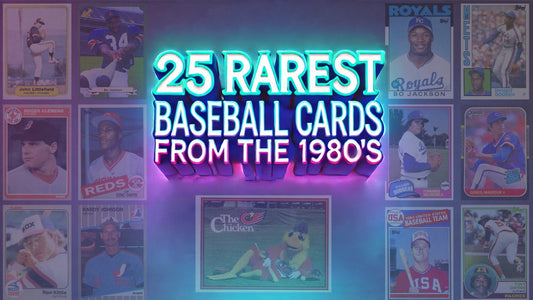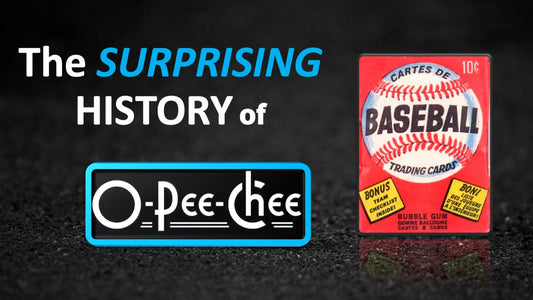Since I just added some 100 Year Old 1909-1911 T206 Tobacco Baseball Cards, I thought I'd share a little about how the age and history of the cards had impacted me and a little bit of the history of these cards.
The T206 set of tobacco baseball cards is one of the most iconic and sought-after collectibles in sports history. First distributed in 1909 by the American Tobacco Company (ATC), the T206 set features over 500 different cards depicting popular baseball players of the time. The cards were included as inserts in ATC cigarette packages and were highly prized by collectors even during their initial release. Today, T206 cards remain highly sought after, with some individual cards fetching millions of dollars at auction.

To understand the significance of the T206 set, it's important to look at the context of its creation. In the early 1900s, baseball was already one of the most popular sports in America. The rise of professional baseball in the late 1800s had given way to the formation of the National League and the American League, and the sport was rapidly gaining a large and passionate following. At the same time, tobacco companies were among the most powerful and profitable corporations in the United States, with the ATC being one of the largest.
The ATC recognized the popularity of baseball and saw an opportunity to capitalize on it by including baseball cards in their cigarette packages. This was not a new concept, as other tobacco companies had already experimented with including baseball cards in their products. However, the ATC took the idea to a new level with the T206 set. The company hired a team of talented artists to create the cards, and the result was a visually stunning collection of cards that captured the essence of baseball during its Golden Age.
The T206 set was first released in 1909 and continued to be distributed until 1911. The cards were included in a variety of ATC cigarette brands, including Piedmont, Sweet Caporal, and Hassan. Each pack of cigarettes contained one card, which could be a portrait or action shot of a player. The cards were printed using the "lithography" technique, which involved the use of stones to transfer the image onto the card. The lithography process allowed for a high level of detail and color accuracy, which made the T206 cards stand out from other baseball cards of the time.
One of the most unique aspects of the T206 set is the wide range of players represented. The set includes stars such as Ty Cobb, Christy Mathewson, and Honus Wagner, as well as lesser-known players who have since faded into obscurity. The cards also feature a variety of poses and settings, with some players depicted in action shots on the field and others in more casual poses off the field. The range of players and poses made the T206 set highly appealing to collectors, who sought to collect as many different cards as possible.
Of all the players featured in the T206 set, one stands out as the most famous and valuable: Honus Wagner. Wagner was a legendary shortstop for the Pittsburgh Pirates, widely considered one of the greatest players of all time. Wagner was a fierce competitor and a consummate professional, known for his incredible defensive skills and his ability to hit for both power and average. However, what makes Wagner's card so valuable is not just his prowess on the field, but the rarity of the card itself.

This Honus Wagner T-206 — sells for record $7.25 million in 2022
It is believed that Wagner objected to the use of his likeness on the T206 card, possibly due to his association with the American Tobacco Company. As a result, it is believed that only a small number of Wagner cards were produced before the printing plate was destroyed. Today, only around 60 Wagner cards are known to exist, making it one of the rarest and most valuable sports collectibles in the world. In 2016, a Wagner card sold for a record-breaking $3.12 million at auction, making it one of the most expensive trading cards ever sold.
The T206 set remained popular throughout the early 20th century, and many collectors worked to complete their collections by trading with other collectors or purchasing individual cards from dealers. However, the popularity of baseball cards declined during the Great Depression and World War II, and many collections were lost or destroyed during these difficult times. As a result, T206 cards became even more rare and valuable in subsequent decades.
In the 1980s and 1990s, sports memorabilia collecting experienced a resurgence in popularity, and the value of T206 cards skyrocketed. The cards became highly sought-after by both serious collectors and casual fans, and prices for individual cards continued to climb. In 2019, a rare T206 "Jumbo" Wagner card sold for a record-breaking $3.25 million, solidifying the set's place as one of the most valuable and iconic collectibles in sports history.
The T206 set was produced and distributed over a period of three years, from 1909 to 1911. While the set as a whole is highly prized by collectors, there are some notable differences between the cards produced in each year.
One major difference between the 1909 and 1910 cards is the presence of team designations. In 1909, most of the cards did not include any information about the player's team, while in 1910, the player's team was listed on the front of the card. This change made it easier for collectors to identify and organize their cards by team, and it also helped to promote team loyalty among fans.
Another notable difference between the 1909 and 1910 cards is the color scheme. The 1909 cards featured a bright yellow background with a white border, while the 1910 cards had a more muted orange background and a darker border. The change in color was likely a result of the ATC's desire to differentiate the two years of production and create a more cohesive set overall.
In terms of player selection, there were some notable additions and omissions between the 1909 and 1910 sets. For example, legendary pitcher Cy Young was included in the 1910 set after being left out of the 1909 set. Conversely, several players who appeared in the 1909 set were not included in the 1910 set, including Hall of Famers Johnny Evers and Joe Tinker.
The 1911 T206 cards featured a number of significant changes from the previous two years. One of the most notable differences was the addition of several new designs, including the "Carolina Brights" and "Cycle" backs. These new designs featured different advertisements for tobacco products and added to the overall variety of the set.
Another major change in the 1911 set was the inclusion of several new players and the removal of others. Notable additions to the 1911 set included Walter Johnson, one of the greatest pitchers in baseball history, and Frank Chance, a star player and future Hall of Famer. Meanwhile, several players who appeared in the previous two sets were not included in the 1911 set, including Hall of Famers Ed Delahanty and Hugh Jennings.
Finally, the 1911 set featured a change in the numbering system used for the cards. Instead of the sequential numbering system used in the previous two years, the 1911 set used an alphabetical system to identify the different card backs.
Overall, the differences between the 1909, 1910, and 1911 T206 cards are relatively subtle but significant to serious collectors. The changes in player selection, design, and numbering help to differentiate the different years of production and add to the overall complexity and intrigue of the set.
The cards represent a time when baseball was at the height of its popularity, and they offer a glimpse into the lives and careers of some of the sport's greatest players. Whether viewed as a valuable collectible or a piece of history, the T206 set continues to captivate and inspire sports fans and collectors around the world.








